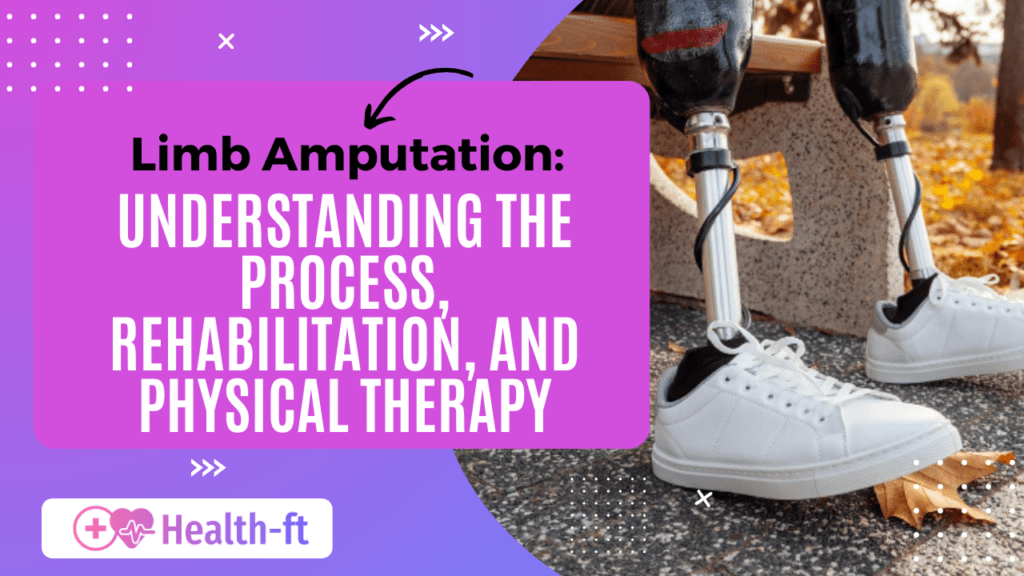Limb Amputation: Understanding the Process, Rehabilitation, and Physical Therapy
S
Understanding Limb Amputation
Limb amputation is the surgical operation where a physician decides to remove part of a limb or an entire one that is, an arm, leg, hand or foot among others.
The causes of amputation vary widely and may include:
-
Trauma:
Surgical operations caused by vehicular or work-related accidents involving loss of limb may require amputation since they are irreparable.
-
Infections:
Any acute infections may culminate to gangrene due to poor healing in the affected areas if caused by diabetics, or people with other forms of immune compromise. While in such cases the only available solution may be to amputate so as to arrest the spread of the infection.
-
Chronic Diseases:
Various diseases such as diabetes, peripheral artery disease or osteomyelitis can cause injury to the tissues and arteries that in turn may require amputation.
-
Cancer:
Malignancies arising from bones or soft tissues that are irresectable because removal will require thorough resection of an entire limb might lead to this.
-
Congenital Conditions:
Some babies are born with improper limb development, or malformations that make it necessary to amputate the limb to enhance their lifestyle.
Although most people realize that limb amputation is usually done as a final measure, it may be a very effective measure in a good number of circumstances.
The Amputation Procedure
Amputation may be elective if the decision is made and prepared carefully to avail the best change for the patient. Surgeons always try to resect as uninformed as possible and spare that limb’s tissue.
The procedure involves:
-
Preoperative Planning:
Circumstances & factors that determine amputation From the investigations, surgeons measure the affected limb and choose the degree of amputation. This is the case because it known that the level depends with position of healthy tissue as well as the condition necessitating the amputation.
-
Surgical Removal:
During the surgery the damaged or diseased part of the limb is excised by the surgeon under the same applied principles as involving vessel and nerve structures. The bone is specially designed for the artificial limb, whereas muscles and skin nudge the bony structure.
-
Postoperative Care:
The nursing care patient postoperatively involves the close observation for main procedures complications as the infections and blood clots. There is great concern on the management of pain and wound care at this stage.
Patients who have had to under go an amputation, they are left with both physical and psychological complications. To support them to regain their independence the process of healing and rehabilitation is crucial.
Physical Therapy for Amputated Leg
Indeed, among various basic measures of management in the initial phase after a limb amputation physiotherapy for amputated limbs is one of the most crucial steps in the recovery process. Physical therapy is started soon after surgery and continues until the patient’s recovery and rehabilitation phase. It is essential in teaching the client how to cope with life without the limb and, in the event the client is to be fitted with a prosthetic limb, the interface has to prepare the client.
Initial Physical Therapy
Immediately after the amputation, the focus of physical therapy is on:
-
Pain Management:
Some of the complications, which occur include; Phantom limb pain (the feeling that the limb is still present after amputation). Desensitization and mirror therapy physical therapy methods may help treat this pain.
-
Stump Care:
Successful management of amputation includes adequate dressing of the residual limb to prevent infections, swelling of the stump, preparation of the stump for prosthesis. Physical therapist become role models for the patient and educate them on the proper techniques touch and hygiene of their residual limb.
-
Strength and Conditioning:
Goals for the initial physical therapy are to help the patient keep the muscle groups remaining as strong as they can become and to promote cardiovascular physical fitness. A therapist may work with a patient to do simple exercises including bed mobility, transfers, and other range of motion activities.
-
Rehabilitation in Case of Amputated Legs:
Amputation of leg rehabilitation is an organized process aimed at restoring mobility in patients with a leg amputated.
The goals of physical therapy at this stage are:
-
Improving Balance and Coordination:
This can be challenging since patients lose sensation in part or all of one or both legs and may be required to learn how to stand without falling. They develop programs for this flexibility and focused on the abdominal muscles, teaching patients how to walk with the help of special gears, such as walkers, crutches, etc., during early rehabilitation.
-
Strengthening Remaining Muscles:
Limb-sparing patients would concentrate on the muscles in the remaining leg(s) and abdominal wall strength needed for balance and walking with or without a prosthesis.
-
Gait Training:
Recovery from an amputated leg is not easy; however, PT emphasizes the correct biomechanics of walking. Patient uses parallel bars among other equipment among other equipment so that the therapist can practice on walking while still being supported.
Rehabilitation is not a one day affair, but works hand in hand with the physical status of the patient, level of amputation, as well as the desire to get back on the feet.
Prosthetic Leg: Physical Therapy and Adjustment
To many people using a prosthetic leg is considered one of the milestones towards recovery whether fully or partially after amputation of their leg. Physical therapy of the prosthetic legs is important in the treatment regimens to facilitate the correct usage of the prosthesis by the patient. Phases involved in the process of receiving a prosthetic leg and finding its appropriate fit are several, while physical therapy is important at every stage.
Fitting the Prosthetic Leg
The starting point is the fitting of the prosthetic leg. This entails a process of manufacturing a device that will fit perfectly on the residual limb with out causing any form of discomfort to the stump. The prosthetist strives to fit a good prosthesis, and the physical therapist also provides basic instructions on how to use them.
-
Proper Fit:
The prosthetic should fit the patient very well in order to allow comfortable movement. A poorly fitting prosthetic results in skin breakdown, friction, and infection to the residual limb.
-
Weight Distribution:
Amputees have to understand how they have to stand on the prosthesis so that they do not use their other leg too much to compensate, which can easily lead to other issues such as muscle issues.
Rehabilitation with a prosthetic limb
After amputation, prosthesis is attached to the residual limb and perceived functional exercises aim to facilitate the patient to adapt well with the prosthesis.
The goals of physical therapy for prosthetic legs include:
-
Prosthetic Leg Training:
In that case, patients are or led through the process of walking using their prosthetic leg while emphasizing on balance, coordination and mechanics of walking. At an initial stage, the patient is immobilized and may require the use of walkers, parallel bars, crutches or a walking stick.
-
Strengthening Muscles:
It was noted that much attention should be paid to the musculature of the residual limb, non-amputated limb, and the abdomen for optimal use of the prosthesis. Depending on the degree of disability a physical therapist will devise specific strength training regimes to improve the muscle abilities.
-
Gait Re-Education:
Rehabilitation in a person who received an amputation usually requires adapting to a new walking gait. Gait re-education enables the patient to specific on the smooth transfers to avoid limping and transfer of weight effectively.
-
Prosthetic Control and Adaptation:
Physical therapy also involves managing patients’ use of prosthetics when performing tasks in diverse contexts including walking on slopes, climbing steps or from sitting to standing.
Psychological Adjustment
Thus, in addition to all the physical components of prosthesis, there is a psychological component in its use. Self-care involves the use of medication to treat many patients as they develop such feelings as frustration, anxiety, or depression. Physical therapists, also to the emotions, cooperate with mental health workers to guide the patient through the psychological barriers that the patient must face as they follow rehabilitation with the help of a prosthesis limb.
Long Term Physical Therapy and Chronic Physical Therapy Maintenance
If patient needs lifelong other limbs physical therapy after initial period of rehabilitation may be needed, like with the amputated limbs or prosthetic legs. But Satan is within the fact that the body shapes as well as the residual limb evolve over a period of time and this may compel adjustments on the prosthetic. It makes physical therapy ideal with the potential of helping patients get used to the change and still be able to gain further mobility and better quality of life.
Continuation of Strength and Conditioning
Physical fitness should be kept up to standard in an endeavor to enable patients wearing prosthetic legs be able to continue with their active lifestyle. PTs can also prescribe lifelong exercise routines that will help a patient build overall body strength, balance and flexibility.
Monitoring the Residual Limb
The residual limb may vary particularly in size and shape and is influenced by muscle atrophy and weight changes. There are changes to the body over time and working with the prosthetist and a physical therapist to see and realize these changes that need to be made to the prosthetic limb so that it can fit comfortably and properly on the body.
Conclusion
Surgery of this kind is a big change in the lives of those affected, it means that the person has to lose a limb but this does not necessarily has to be the end of the story because through support and physical therapy, a lot can be done to ensure that the person is fully mobility again. Amputations of the legs can be treated by a physical therapist who will assist the patient in regaining the strength of the remaining muscles, how to balance themselves and learn how to use the artificial limbs.
Asthetic surgeries for the amputation patients ensure that those who are adjusting to the prosthetic leg continue with the physiotherapy so that they can get used to the new limb, have the correct posture as well as gait pattern as they try to get the best quality of life that they could possibly have.
Often, it is a painful process, but the use of prosthetic legs in conjunction with the rehabilitation program to make the results significantly better compared to the person who has amputated limbs.
FAQS
- What is limb amputation?
Amputation of limb refers to the surgical removal of a limb, whether it be an arm, a leg, hand or a foot owing to injury, infection, diseases or some other ailment.
- What are the leading causes of limb loss?
Some of the leading causes embrace massive injury, uncontrolled diseases, and prolonged diseases such as diabetes or peripheral artery disease, and, finally, tumors within the limbs.
- What does one undergo when he/ she has to undergo an amputation surgery?
Rehabilitation is performed through physical therapy for better balance, increased strength, coordination and movements of the body part. It also contains activities for the rest of the muscles helping the residual limb in the preparation for prosthetic if required.
- What is the physical therapy of having legs amputated?
Amputations of the leg require such PT tasks as strengthening, balance and coordination, through exercises involving the residual limb and trunk muscles. .





